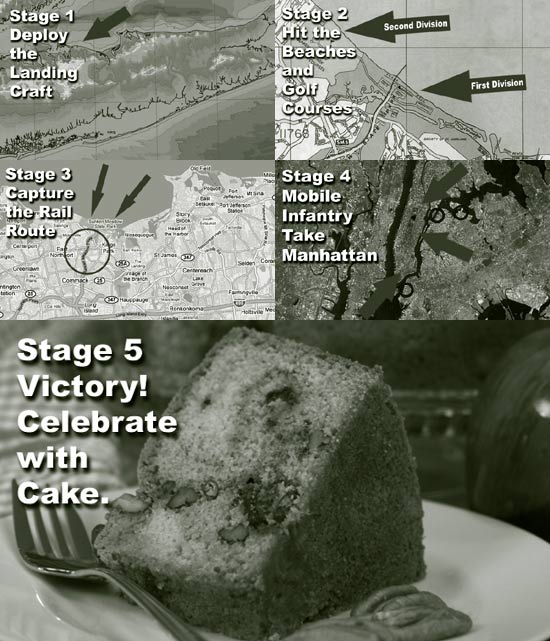
Monthly Archives: April 2007
Rebo & Zootie in Your Army’s Privates
Zootie gets a telegram from his brother which helps reveal something of Rebo’s past.
So You Want to Invade Long Island?

There is only one real reason you would attempt to land a large expeditionary force in Long Island, and that is to seize New York City and possibly the port facilities in Brooklyn and New Jersey. Therefore, the following ideas will assume that that is your goal and that to achieve that goal you would need at least an Army Group (let’s say five divisions plus support and transportation units) and a large fleet of transport vessels and escorts, including a carrier group and plentiful ground-support gunships or fixed-wing craft.
The best time for an invasion would be around late summer in order to have good weather conditions for an autumn campaign. Ideally, you want to be able to seize control of New York City before the deep winter begins in January. The urban environment would provide excellent winter billets for a large army group as well as easy access to food and fuel supplies. A bitterly cold winter would be a good time for digging in, destroying bridges and establishing a defence perimeter. Snow and other adverse weather would make major sorties by enemy troops into your position difficult at best and will help to prevent overflights of your airspace by enemy units.
The first wave off the LSTs will need to be infantry or possibly marines. Thus, the Army Group should be composed of two divisions of infantry, two divisions of mobile infantry and one armoured division. The first division will secure the beachhead and allow time for some heavier equipment to be brought up. While armour will be important to repel any heavy counter attack, for the most part heavy armour will be a hindrance in the densely populated urban areas. It would be best to have light tanks and self-propelled artillery, with a few heavier tanks available to conduct coordinated attacks on strong enemy positions.
An ideal landing spot can be found just east of Northport Bay at the adjacent Crab Meadow Park, Indian Hills Country Club and Sunken Meadow State Park. While the south-eastern portion of this coast-line is marshy, the north western areas, around the golf-courses, have large open areas and massive parking lots just off the beach that will allow for easy movement of heavy equipment. Once a beachhead is established, smaller elements will need to move north to capture the US Coastguard Station on Duck Harbour Island, while other units will move south down Fort Salonga Road to secure the rail station and lines off E. Northport Road in Kings Park.
Sunday the 19th of August would be a good D-Day, as the tide will be almost seven feet just after 4am which will allow your first wave LSTs to get fairly close in to the shore. Within a few hours, once a beachhead and foothold are established, elements of one mobile infantry division will seize Macarthur airport, while the armour and other mobile infantry move via the Long Island Expressway through to the west before splitting up to take control of the ConEdison power plant and LaGuardia Airport on the north shore, as well as the shipping facilities located in New York Harbour. Engineers and support troops can then be brought up to the airports, allowing supply and reinforcement to be deployed by long-range transport aircraft.

Air support will be utilized to destroy bridges, rails and roadways leading into New York City, especially those that lead across the Hudson River, while fleet based gunships can be used for recon as well harassment of any enemy troop formations in the open.
In this campaign, the most important thing to remember is speed; get ashore, find your means of transport and move west. Only key points like airfields and port facilities need to be held. Other infrastructure can be destroyed, though it will be important to minimize collateral damage and civilian casualties.
It is likely that there would be little resistance, allowing for high mobility. Your forces should be able to reach the East River within three days and begin setting up a first prepared position near the Hell’s Gate bridge in north-west Queens. This is the only rail bridge between Long Island and the mainland that is strong enough to carry your heavy armour. These, acting in concert with mobile infantry and air support, will be able flank north into the Bronx, to surround the island of Manhattan. With all automotive bridges and tunnels bombed, Manhattan will be effectively isolated. Heavy air support, operating from LaGuardia can establish air superiority over the harbour, allowing ships to move up the Hudson.
At this point, the civic leaders of Manhattan should be offered the choice of surrendering the city without bloodshed. This would be ideal, as the close, urban areas of Manhattan would make for chaotic CQC, which would make air or artillery support impossible. Should the city resist, it will be necessary to invade. This will slow you down. Two to three weeks of shelling, coupled with air bombardment and sorties by air cavalry troops will weaken the city and its infrastructure.
There should be few enemy troops in New York City, though there may be a large, but poorly armed and disorganized insurgency. One solution to this problem would be to order a civilian evacuation; round up all the citizens and force them to march along all major roads out of the city. Not only will this clear out many insurgents and make them more easy to identify, it will also choke the roads with refugees, delaying any enemy counterattack.
At this point you will have succeeded in your invasion. Congratulations, you have conquered New York City. Secure all important infrastructure like power plants, storage depots and communications centers and procure supplies and billets for your troops. With New York’s harbour and airports secured, the Theatre C-in-C will be able move more reinforcements and supplies with ease. Now that your objective has been met, you should probably discuss this with the Theatre Commander and find out the best way to proceed.
Things You Can Do With Tongs!
Farmers’ Own

